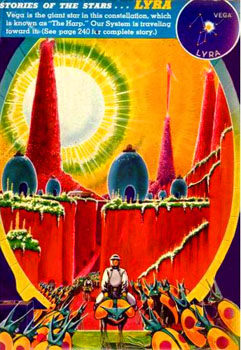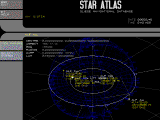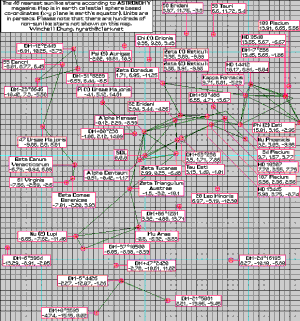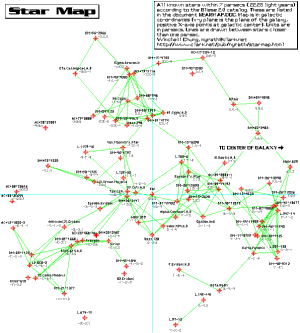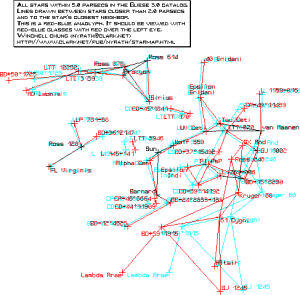Windows Applications
AstroSynthesis
AstroSynthesis is not free, but is a "must have" program.
The pre-production version had automatic route creation, filtered by galactic empires, handled spheres of influence, and even generated *.AVI movies walking through the map. It also allowed importing your own star databases.
The current version, version 2.0, is even better and adds tons of "must-have" features. It handles about a hundred times as many stars, and includes various star searching functions. It import/export XML files, has sophisticated orbital mapping for solar systems, and transit time calculation. It has movable markers for starships, fleets, and other objects. It handles sub-sectors. Planets icons can be replaced by national flags. And it will accept third party plug-ins written in VBScript for solar system generation.
If you are serious about starmapping in general and interstellar empires in particular, you owe it to yourself to get this program. Recommended!
Project AstroFly
Project AstroFly is a 3D starmapping program that includes both the Hipparcos and Tycho catalogs. This is a most powerful program. View location can be set anywhere in space, stars can be filtered by several parametersm, stars can be located on the Hertzsprung-Russell diagram, and a wireframe outline of the galaxy can be superimposed on the map. (Thanks to David Gordon for suggesting this link.)
Celestia
Celestia is a dynamite and scientifically accurate star program. It has about 200,000 stars (2.1 million with the add-on) and a full set of planets, including the extrasolar ones. It is freeware, for Mac, Windows, and Linux. (Thanks to Michael A. Piva for suggesting this link.)
Partiview
Partiview For Mac, Windows, Linux and IRIX. Joseph Kulhavy had this to say about Partiview:

Partiview is an interactive data visualization tool written by Stuart Levy at the National Center for Supercomputing Applications (NCSA) that enables static and animated data visualization in 3-D and can display 2-D images and 3-D polygonal models as well; Partiview is a generalized software tool used in many different scientific data display applications.
Since 1998, the Office of the Director of the Hayden Planetarium (within the Department of Astrophysics, American Museum of Natural History) has underwritten the development of a shell wrapper and a series of data sets for various stellar displays including Partiview, thereby creating an extremely powerful desktop planetarium. In fact, the data sets can be adapted (with third-party add-ons) to control globe-planetarium projection, as used at the Hayden Planetarium.
These data sets have been aggregated with Partiview as a downloadable software package titled "Digital Universe", as featured in a cover-story article in Natural History a couple years ago ("Virtual Universe" April 2004). For more information on the Digital Universe Atlas, see http://www.haydenplanetarium.org/universe/. Digital Universe was written by Brian Abbott, Carter Emmart, and Ryan Wyatt.
The various data sets include the Milky Way Atlas, the Extragalactic Atlas, a simulation of the WISE brown-dwarf survey, and other items, all displayed in a fully navigable 3-D environment.
Professional astronomers have written other extensions for Partiview over the years to include features like planet modeling, stellar evolution, embedding (as an add-on) in LightWave3D, spacecraft tracking, and so on; more information is available at http://groups.google.com/group/partiview. Partiview has been particularly useful for astronomers; various visualizations include orbit patterns around black holes, 3-D structures of supernovae, and so on.
Although Partiview was developed in a Unix environment, Digital Universe ("DU") has wide cross-platform compatibility, and is available in easy-to-install packages for Windows, Mac OS X, Linux, and IRIX.

It's Full Of Stars!
It's Full Of Stars!, by Claus Børnich, is an IBM program in PKZip format (about 1.6 meg). This exceedingly useful freeware program allows one to map local space, assign empires, races, and solar systems. It's a big file, but it is worth the download. And please give Mr. Børnich some feedback. It's little enough to pay for such a worthwhile program.
Starmap
Starmap For Linux/Unix and Windows. Source code uses the wxWindows C++ cross-platform application framework.
Star Gen
Star Gen is a freeware program that generates solar system using the Accrete algorithm. Freeware for Mac, Windows, and Linux, and it even includes the source code! There is also an online version.
SauronWeb 3D Star Map
SauronWeb 3D Star Map is a Windows application for rotating starmaps, and labeling system for interstellar empires and whatnot. Unfortuantely it seems to have become orphan software.
Star Generator
Star Generator is a program that generates star systems for RPG games.
Star 3
Star 3 is a Windows program that reads in Gliese star data and outputs VRML files.
Accrete
Accrete is a program that generates solar systems by mathematically simulating a collapsing nebula and the accretion of planets. I believe it was originally written in some version of C by Matthew Burdick, based on RAND study by Stephen Dole.
Here is the original archived source code from ftp://caliban.physics.utoronto.ca/pub/accrete.tar.z.
For those trusting souls out there who are [a] are not afraid of computer viruses and [b] do not have C compilers; here is the IBM executable version of the program (about 82K) and the Macintosh executable (about 64K, in BinHex 4 format).
Each time you run it, a file called "NEW.SYS" is produced. This is a text file containing all the info about the newly created solar system. There seem to be a bug, as no file is created if "Collision between two planetesimals!" happens.)
And here is a sample solar system generated by Accrete. In this output file, the heading "Smallest molecular weight retained" refers to the planet's atmosphere. Look at this list of atmospheric gasses. The only gases one could find on a given planet will have molecular weights greater than the "smallest weight retained". For instance, if the smallest is 45, one could only find Nitrogen dioxide, Ozone, Sulfur dioxide, Sulfur trioxide, Krypton, and Xenon. As for which of these actually occur in the planet's atmosphere, that is for you to decide (translation: there is no conceivable way to calculate that). If the smallest is greater than 130, the planet is airless. Also note that Accrete generates the star's characteristics, like mass and luminosity. You will have to match the star to an existing star, if you are really nit-picky about these matters.
Ian Burrell made a Java applet version of Accrete, and has made the source code available. He also has versions of Accrete from other sources.
A Program for the Last Stages of Terrestrial Planet Formation
Here is a link to a starsystem generator program for IBM Windows. It is based on a new theory of planetary formation.
World Builder
Here is the source code for World Builder, a program that helps designing planets to specifications. It is written in BASIC by Stephen Kimmel. IBM Windows users can run this program using QBASIC.EXE, if your version of Windows was thoughtful enough to include it.
NearStar
Here is NearStar, an IBM program in PKZip format created by Wayne Young. It displays lots of nearby stars, and rotates them in real time. The user can select stars and the program will calculate the distance between them. The program was created as a play aid for the game 2300AD. Now includes the Pascal source code!
Star Atlas
Mark Smith has used the Gliese data to make a remarkable program. Jump here to check it out! Now it includes a downloadable demo for IBM windows!
Warp Now
Max Lambertini has created a marvelous program for mapping and managing the stars within 100 light years! Warp Now can print out starmaps, chart routes between stars with user settable maximum distances, and generate solar systems using a system similar to the 2300AD RPG. This web site also has other goodies for system builders, check it out!
CircumSpace
CircumSpace is an IBM shareware program that includes the closest 7780 stars, and allows one to move around like a software starship. It can be used to see what the sky looks like at other star systems. The file is in PKZip format (about 185K).
PostScript Star Mapper
The PostScript Star Mapper by David Morgan-Mar produces "flattened" 3-d starplots as well as oblique views.
Starmap
Jim Vassilakos' Starmap is a 3-D starmap generator/viewer for IBM MS-DOS. This is quite a package, with lots of meat in it. It is intended for a SF novelist or a role playing game referee, but has something for everyone. It also includes archives of a prolonged discussion on the internet on the topic of alien races, stardrives, and planetary civilizations. The mapping program displays stars, and will allow the user to create and display the associated solar systems, make planetary maps, and attach detailed notes. This one's a keeper!
3D Stars
Thomas York's 3D Stars is a program for IBM MS-DOS, Windows 9.x or XP. This allows one to physically fly around a 3-d model of the local star group. You can also run the stars forwards and backwards in time plus or minus a million years or so, to see the effects of stellar proper motion. There is also a starmap maker program available. 1,400 stars in the unregistered version, and over 2,500 in the full version.
Flash! 3D Stars is now in version 1.1! Now the unregistered version has 2,500 stars, and the registered version has the Gliese catalogue added to that. New options include lens flare and configuration files.
Flash again! 3D Stars is now in version 1.2! (It's free, too). It has two star catalogs with 30,000 stars, and a pulsar catalog that demonstrates the galactic disk. It also has a 2-d chart maker.

This is a sample map from 3D Stars, a program that allows you to move through the local stellar neighbourhood in 3D and create images of it. This map is a parallel projection onto a plane 52 by 39 lightyears in size, centred on the sun. The plane is facing the constellation Pisces (for those who know, that's RA:0h 0m 0s and Dec:+0 0m 0s). All the stars on the map have Bayer letters (alpha, beta, gamma etc) and are brighter than about magnitude 6 (absolute). The full program allows any position/direction planes to be used.

StarStrider
StarStrider is a nifty shareware program ($38) for Win95 or later. This uses the Hipparcos data. Don't think that it's underpowered just because it's shareware, this program does it all! All the star names, real time 3-D rotation, it even does red-blue anaglyph images! Check this sucker out. It's well worth the shareware fee.
StereoStar
StereoStar is my own experimental program for IBM Windows. It allows one to load in a map based on the Gliese data and rotate it in 3-D. You can view it as 3-D with the cross-eyed or wide-eye method, or by using red-blue anaglyph glasses.
Macintosh Applications
Celestia
Celestia is a dynamite and scientifically accurate star program. It has about 200,000 stars (2.1 million with the add-on) and a full set of planets, including the extrasolar ones. It is freeware, for Mac, Windows, and Linux. (Thanks to Michael A. Piva for suggesting this link.)
StarGen
StarGen is a freeware program that generates solar system using the Accrete algorithm. Freeware for Mac, Windows, and Linux, and it even includes the source code!
Orion
Orion is a Macintosh shareware game that allows one to fly among the stars within 30 light years. It is a lot of fun, and educational too! When you run it, pull down the apple menu to select About Orion. This will give you access to the help file. The file is in HQX format (about 61K.) Thanks to Frank Henriquez for supplying a copy.
PostScript Star Mapper
The PostScript Star Mapper by David Morgan-Mar produces "flattened" 3-d starplots as well as oblique views.
Hypercard Stack
Dr. John Cramer's has a Macintosh Hypercard stack that contains information about Sol's Neighbors.
Unix/Linux Applications
Celestia
Celestia is a dynamite and scientifically accurate star program. It has about 200,000 stars (2.1 million with the add-on) and a full set of planets, including the extrasolar ones. It is freeware, for Mac, Windows, and Linux. (Thanks to Michael A. Piva for suggesting this link.)
StarPlot
StarPlot: A 3-Dimensional Star Chart Viewer. For Unix, freeware, source code available under the GNU General Public License.
Starmap
Starmap For Linux/Unix and Windows. Source code uses the wxWindows C++ cross-platform application framework.
GNU SpaceChart
GNU SpaceChart For the GNU/Linux, FreeBSD and Solaris 8. Gnome environment.
Star Gen
Star Gen is a freeware program that generates solar system using the Accrete algorithm. Freeware for Mac, Windows, and Linux, and it even includes the source code!
PostScript Star Mapper
The PostScript Star Mapper by David Morgan-Mar produces "flattened" 3-d starplots as well as oblique views.
Java, Online, VRML, Excel, or other
StarMap
StarMap is an online Java application which can manipulate a 3-D starmap. It includes details about how the application and dataset were created.
Excel Spreadsheet
Here is a quick-and-dirty Microsoft Excel spreadsheet that will calculate X,Y,Z co-ordinates for you.
The Galactic Gazetteer
The Galactic Gazetteer is a JavaScript application that allows rotating starmaps in real time.
Hyades
Hyades is an online map of the Hyades star cluster (requires downloading a plug-in).
SGC Galactic Tri-Coordinate Calculator
Here is the SGC Galactic Tri-Coordinate Calculator for the SGC Galactic Coordinate System by James Shuster. Send an email per instructions for the Excel spreadsheet.
Virtual Universe
The Virtual Universe v1.0 is a nice VRML demonstration of the stars within 50 light years by Don Ware.
Trade Routes
Keith Wetzel has a nice set of web pages with indexed data for interstellar trading routes. Click here to give it a try!
VRML by Darren Garber
Darren Garber has VRMLs of the 64 closest stars, and another of bright stars within 100 light years of the sun. Plus tons of other neat stuff.
Star View
Ed Hobb's Star View is a Java applet that allows you to navigate around the closest 272 stars to the sun. Works really smooth, too!
Old Starmaps
Map by Nelson Cunnington
Nelson Cunnington has a made a very professionally done starmap. It shows the stars within 25 light years in gorgeous color! Nelson is a professional, but impoverished, graphic designer and so will not draw maps to order for nothing, so please don't ask. He is, however, gloriously egomaniacal, so please feel free to email him praise for his map.
Take These!
Here are some maps I made. SF Authors please note: feel free to use this map when designing the universe your novels exits in. If you do, it would be nice to mention me in the credits, but I do not insist upon it.
46 Nearest Sunlike Stars
This sample starmap has the 46 nearest sunlike stars. Lines are draw between stars closer than a certain distance (but I forgot what that distance is). By the way, take a look in the upper left hand corner. There is a nice trio of stars that are very close to each other, but far from anybody else (DM-12°2449, DM-23°8646, and DM-31°6229). They would make a nice little pocket star empire.
Gliese 2.0 Within 7 Parsecs
This newer sample starmap is in honor of this web page's 5000th hit. It is all the Gliese 2.0 stars within 7 parsecs, in galactic co-ordinates, with lines draw between all pairs of stars closer than one parsec. The map was generated by the data in the file nearmap.doc, mentioned below.
Gliese 3.0 Within 5 Parsecs
This anaglyphic starmap has all the Gliese 3.0 stars within 5 parsecs, in equitoral co-ordinates, with lines draw between all pairs of stars closer than 2 parsecs. You will need red-blue anaglyphic glasses, which are available here. If you are interested in how this map was made, check this website's section See A Show In Ster-ee-oh.
Brad Jones' Program
Here is the IBM and Macintosh source code for a program written by Brad Jones which will read in the Version 3 Gliese data, accept user input for various filter criteria and outputs a text file with the results. It will also allow you to set the origin to something other than the sun, and has three different levels of verbosity for the output. Very nicely done. It is written in C. It is based on my cheezy little program below, but don't hold that against it.
For those trusting souls out there who [a] are not afraid of computer viruses, and [b] do not have a C compiler; here is the IBM executable (about 55K) and the Macintosh executable version of the program (about 46K), in a BinHex4 file(. You will also need the Gliese near star catalog version 3.0 (about 219K). The catalog is in PKZip format, and needs PKUnzip or equivalent to expand it. Make sure that the catalog file is named GLIESE3.DAT and is in the same directory as the program.
Command-line Arguments
When you run the program, it will give you a menu allowing one to set various filter criteria. Or you can set the criteria with command line options: (IBM version only)
| Argument | Function | Default |
|---|---|---|
| -n | Turns on non-interactive mode | |
| -ref X Y Z | Sets the reference point to (X, Y, Z) | (0, 0, 0) |
| -mindist X | Changes minimum distance to X | 0 |
| -maxdist X | Changes maximum distance to X | 5 |
| -minlum X | Changes minimum luminosity to X | 0 |
| -maxlum X | Changes maximum luminosity to X | 200 |
| -nobin | Turns off binaries | Binaries on |
| -long | Turns on long output | Short output |
| -xlong | Turns on extra-long output | Short output |
| -o FILE | Sets the output filename to FILE | 'gliese3.out' |
X, Y, and Z are numbers; FILE is a filename.
Human habitable planets are currently believed to occur around stars with luminiosities between 0.4 and 2.0.
Sample Output
Here is a sample output file (about 28K) "filtered" so to only list stars that within five parsecs, listed in "-xlong" verbose mode.
Here is the entire Gliese 3.0 catalog in "-xlong" verbose mode. (about 224K) It is in PKZip format.
Gliese 2.0 Filterer
Here is the source code for a quick-and-dirty little program which will read in the Version 2 Gliese data, accept user input for various criteria used to filter out certain stars (say, if you only wanted stars likely to have human habitable planets), and outputs a text file with the results. It is written in IBM Turbo Pascal 5.0. So sue me. ;)
For those trusting souls out there who [a] are not afraid of computer viruses, [b] do not have Pascal compilers, and [c] do have IBM computers; here is the IBM executable version of the program (about 17K). You will also need the Gliese near star catalog version 2.0 (about 96K). The catalog is in PKZip format, and needs PKUnzip to expand it. After unpacking, rename GLIESE2.DAT to GLIESE.DAT. Macintosh version will be created Real Soon Now.
The program only reads in the Gliese 2.0 catalog, not the 3.0. I'm working on it...
Sample Output
Here is a sample output file "filtered" so to only list stars that are not binaries, and with luminosities between 0.4 and 2.0. This represents a good guess at the kinds of stars that might harbor human habitable planets.
Here is a sample output file of the entire Gliese 2.0 catalog.
Here is a sample output file of all the Gliese 2.0 stars closer than 7.0 parsecs (about 22.8 light years).
Here is a sample output file of most of the stars that have actual names (i.e., "Spica" instead of "Kappa Fornacis"). Please note that unlike the other sample output files, all the co-ordinates are in Light Years instead of Parsecs. Also note that as a general rule, "named" stars are huge, blazing hot, and short-lived suckers who are very unlikely to have human habitable planets.
Most of the human habitable suns are so relatively dim that they cannot be seen with the naked eye. Therefore, they were not named by poetic ancient arabs, but instead by pedantic scientists who, more often than not, just gave them boring catalog numbers. That is why you'll find so many stars in these lists with drab names like DM-24°263 and LTT 10070. (Notable exceptions: Barnard's Star and Van Maanan's Star). Please note that bright stars are useful as names for stellar "sectors". In Issac Asimov's PEBBLE IN THE SKY, Earth was in the "Sirius sector".
